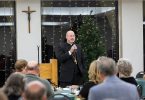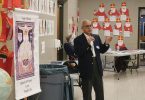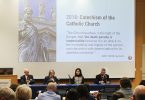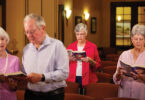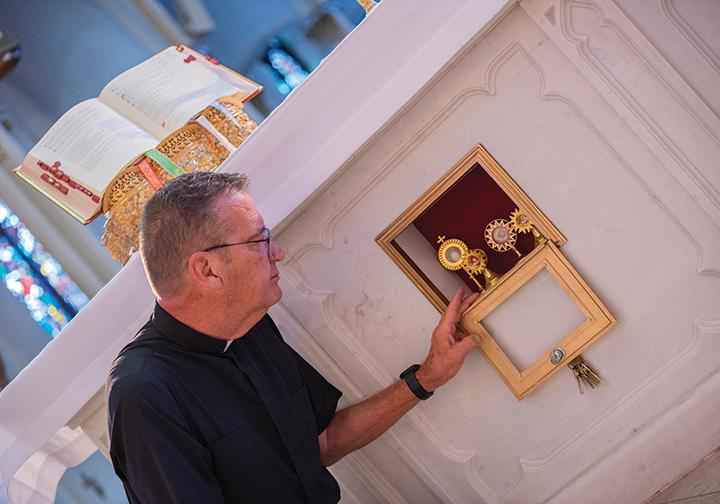
by Joe Bollig
joe.bollig@theleaven.org
KANSAS CITY, Kan. — If you have an opportunity to visit the magnificent Cathedral of St. Peter here, don’t miss the two alcoves flanking the gold-colored crucifix above the tabernacle.
The alcoves are part of a backing, called a reredos, to the original, pre-Second Vatican Council altar. In the past, the alcoves simply looked like empty spaces.
But they were hiding a treasure trove.
The backs of those alcoves are actually sliding marble panels. And behind the panels are literally hundreds of saints’ relics in containers called reliquaries.
These days, the panels are kept open so the faithful can see the relics, but there are other relics in the cathedral that aren’t often — or ever — seen.
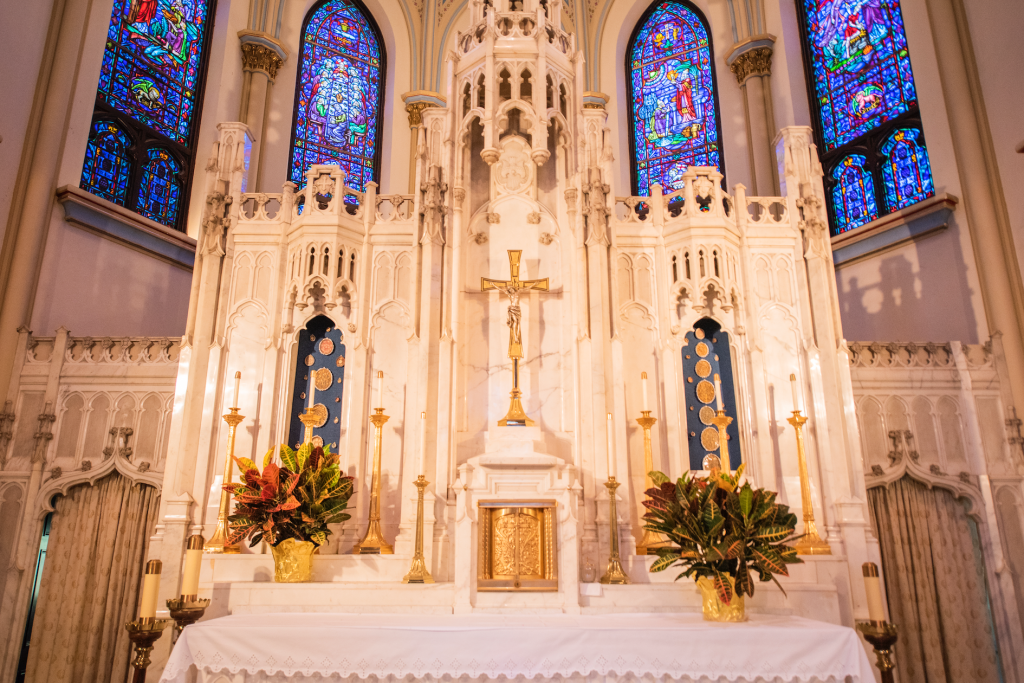
For example, in the back of the freestanding altar, where the priest stands while celebrating Mass, there is a rectangular, brass-edged door where other relics can be seen through glass.
According to an inventory done this past summer by Father Keith Chadwick and seminarian Aaron Waldeck, the cathedral has 240 relics in the two alcoves.
The word “relic” comes from a Latin word for “something left behind.”
“A relic is an item, an object, that is either a piece of a saint or something that belonged to a saint, or something that has to do with Our Lord,” said Father Anthony Saiki, pastor and rector of the cathedral.
There are three classes of relics: First-class relics are the body or a piece of a saint’s body (bone fragment, hair, hand or heart); second-class relics were once the saint’s personal possession (a book or article of clothing); and third-class relics are items touched to the first-class relic of a saint.

But a relic is not merely a curious artifact. Relics are considered sacramentals — sacred signs that signify effects of a spiritual nature obtained through the intercession of the church: rosaries, crosses, holy water and certain devotions.
“We venerate relics . . . as an expression of devotion [to a saint] and our belief in the Resurrection, that these saints are in heaven,” said Father Saiki. “We treat these [relics] with a tremendous amount of reverence . . . to foster a relationship with a saint, a way to invite them to be part of our daily and spiritual lives.”
The practice of venerating the relics of the saints goes back to apostolic times and the early martyrs. And the reason we have relics embedded within Catholic altars comes from the practice and experience of early Christians who, fleeing persecution, celebrated the Mass in the catacombs among the bodies of the saints and martyrs, said Father Saiki.
Individual Catholics are not encouraged to own first- or second- class relics. The danger of personally owning such a relic is that they might not be treated with respect.
Canon law expressly forbids the buying and selling of relics as well, but Catholics are permitted to “rescue” a relic if they find one in a pawn shop, garage sale or other place.
But one must be careful when “rescuing” a relic, said Father Saiki. There is a strong possibility that the relics posted for sale online may be fakes.
“I’ve been involved in a couple of cases where people intended to rescue a relic,” he said. “The certificate of authenticity sent with the relic did not match it at all or describe the relic, and because of these inconsistencies, it was obviously forged.”

You needn’t worry about the cathedral relics in the high altar being frauds. Father Chadwick and Waldeck had a good look at them between June 7 and 10 this summer.
“We took all the relics out of the high altar and inventoried what relics we had and who they were of,” said Father Chadwick, associate pastor of Holy Trinity Parish in Lenexa.
“We know these relics were acquired by Bishop Donnelly when we were made an archdiocese and [the see city was] moved from Leavenworth to Kansas City. The story is he wrote to Rome and asked for relics for the cathedral. We didn’t know who was in there or what relics we had.”
They found 34 reliquaries and hundreds of saints and martyrs, and many sainted popes from Peter to Pius V, who died in 1572.
The certificates were all in Latin or Italian shorthand.
“We spent a lot of time rummaging through the martyrology,” said Father Chadwick. “It took quite a bit of time to figure out what the abbreviations stood for. Luckily, Aaron Waldeck has his degree in classics. He was instrumental in figuring out what some of these abbreviations meant. The martyrology had pretty standard abbreviations, so it was a big help.”

There was a time when people didn’t see the relics very often.
“In the mid-to-late 1980s, I asked the rector that we open the relics during November for the feast of All Saints,” said Michael Rebout, parishioner and acolyte for the cathedral.
“He said, ‘I think we can. We’ve never done that, but I think that would be kind of nice.’”
“We’d do it right after Halloween to the feast of Christ the King, and then we wouldn’t open them for another year,” continued Rebout. “Now with Father Saiki here, we keep them open all year-round, so people may come and see them without having to open [the panels] manually.”
The relics were also displayed for a long period during the Jubilee Year of Mercy from Dec. 8, 2015, to Nov. 20, 2016.

There are some relics, which cannot be seen, in the old altar’s altar stone. Other relics were contained in the altar stones of the two flanking side altars, but the mensas (tables) were removed and the reredos left when the cathedral was renovated in 1998. The former side altar’s altar stones are stored in a locked cabinet in the back of the sacristy.
Normally, the church is locked when Mass is not being celebrated, but it is possible for visitors to get a closer look at the relics in the alcoves in the reredos of the high altar upon request, said Rebout.
“Most of the time if you go to the rectory and request that you’d like to see them, they generally will let you go over and look at them or send someone over,” said Rebout. “On occasion, I’ve gone up and unlocked the door to let several people look at them at the same time.
“You may go up into the sanctuary to the main mensa of the altar and look from there. You cannot touch them, but you can get a pretty good look at them.”



